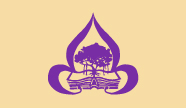
Palm-leaf manuscript written in Grantha script from the archives of
Muktabodha
The Muktabodha Digital Library Project was begun in 1995 as a manuscript microfilming project focusing mainly on photographing at-risk and rare palm-leaf Vedic Shrauta ritual manuscripts from both private collections and libraries. From this phase we have approximately 50,000 frames of microfilm in our archives. Since that time the technology used and the focus have evolved into digitally capturing both Vedic Shrauta ritual and medieval Shaivite manuscripts.
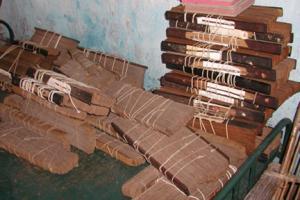
Manuscript collection, Tamil Nadu
Collections microfilmed or digitally photographed include:
- Mysore Oriental Research Institute
- Puliyannur Tantric collections, Calicut Univ.
- Rashtriya Sanskrit Vidyapeetha, Tirupati
- Academy of Sanskrit Research, Melkote, Karnataka
- Oriental Research Institute,Trivandrum, Kerala
- Sri Chandrasekharendra Saraswati Visva Maha Vidyalaya, Kanchipuram
- Sri Venkateswara Univ. Oriental Research Institute, Tirupati
- Dakshinannaya Sharada Pitham, Sringeri, Karnatak
- Nedumpilli Mana I - Irinjalakkuda, Kerala
- Joglekar, Kodlekere and Samba Dikshita collections, Gokarna
PHASE II KASHMIR SERIES OF TEXTS AND
STUDIES
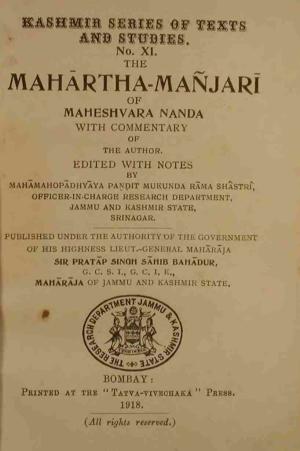
Maharthamanjari, Volume XI of the KSTS Series, printed in 1918,
a text of the Krama school of Kashmir Shaivism
One of Muktabodha's goals is to make available on the world-wide web important texts from our archives.
The initial phase of this goal was realised in July 2003 when the core texts of Kashmir Shaivism were made available to the international scholarly community by publishing 75 volumes of the Kashmir Series of Texts and Studies in our on-line digital library. Thus the core texts of the Pratyabhijna, Spanda and Krama schools of the Non-dual Shaivism of Kashmir were made available worldwide.
Of particular note among these texts are the twelve volumes of the encyclopedic Tantraloka of Abhinavagupta with Jayaratha's commentary.
The existence of these schools of non-dual Shaivism that later became known as "Kashmir Shaivism" was brought to the knowledge of the world outside of Kashmir by Georg Buhler in his report published in 1877 "In Search of Sanskrit manuscripts in Kashmir, Rajputana and Central India". In 1911 a Research Department was set up by the government of Pratap Singh Sahib Bahadur, Maharaja of Jammu and Kashmir with Mukund Ram Shastra as its head pandit. Under its auspices the Kashmir Series of Texts and Studies was published starting in 1911 and extending into the 1960's, but with the last volume related to Kashmir Shaivism being published in 1947. Thus the core texts of the non-dual Shaivism of Kashmir were published, many from manuscripts in the personal possession of the pandits of the Research Department.
The intention was that they should reach libraries and scholars and be studied beyond the Kashmir Valley. In the US, copies of these texts had reached a few research libraries through the US governments's PL480 program.

Tantravatadhanika a volume of the
KSTS Series retrieved from Srinigar
In 2000, Muktabodha identified the value of digitally photographing all the volumes in the KSTS and making them universally available to scholars via the Internet. The aim was to stimulate their wider study and translation. In 2001 Harry Spier was engaged to implement the project of building this online digital library.
One source of the texts photographed for the project was a collection gathered in Kashmir twenty years earlier by two people who later became part of the Muktabodha team. In 1982, on a trip with Swami Muktananda to Shrinagar, to the birthplace of Kashmir Shaivism, they had seen firsthand the fragile state of much of the KSTS endeavor. Gurumayi Chidvilasananda had asked them to locate texts from the KSTS to which that they had seen references to in the footnotes of the handful of translations of texts from the series. In a shed behind the museum in Srinagar they found, highly damaged by mice and the elements, what appeared to be the remaining stock of the series. Not knowing whether these texts were accessible in the US, they purchased two copies of each available volume and deposited sets in India and North America for safekeeping and reference.
It was also through the production of the on-line library of the KSTS that Muktabodha developed the batch processing procedures and techniques that it uses to economically digitize large volumes of manuscripts and books.
The success of this second phase of the on-line digital
library was indicated in its first two years of existence by the
downloading of over 5,800 texts by individuals and institutions in 54
countries. Usage of this collection remains high with approximatedly
15,000 volumes of the KSTS Series downloaded to date.
A particularly high use is from India, Eastern Europe and countries of
the former Soviet Union, indicating that Muktabodha's digital library
is functioning as a source of indological texts for individual scholars
and institutions that have neither the resources nor the access to
obtain these texts by other means.
PHASE III SEARCHABLE ELECTRONIC TEXTS
OVERVIEW
From the end of 2004 until 2018, Dr. Mark S.G. Dyczkowski served as the Academic Advisor for the Digital Library Project. Dr. Dyczkowski selected and sourced the texts and oversaw their electronic transcription. In addition, he trained a team of typists in data-entry and the collation of Sanskrit manuscripts in the Devanagari, Old Newari and Grantha scripts. This team, including Virendra Pathak, Dharmendra Shrivastava, Deobrat Patel and Vinay Mishra created searchable e-texts of a large number of important Tantric/Agamic texts and thereby contributed greatly to the expansion of the library holdings. Since 2018, the creation of searchable e-texts in Muktabodha's Varanasi office has been overseen by Dr. Anirban Dash.
The first searchable e-texts produced for the Muktabodha Digital Library were Kashmiri Shaiva texts from the Kashmir Series of Texts and Studies (KSTS). We began there for several reasons. One is simply that Muktabodha's Digital Library began by focusing on the monistic Kashmiri Shaivism, as its great depth and excellence was frequently quoted and expounded by Muktabodha's founder Gurumayi Chidvilasananda and her Guru, Swami Muktananda. So the Digital Library began online with photographic images of the KSTS Series, and the e-text collection complemented these by producing all the texts from this Series which other scholars had not made available elsewhere online. The texts made available included works such as the Tantraloka of Abhinavagupta with Jayaratha’s commentary.
The other reason for this starting point is that the Kashmiri Shaiva texts are one of the most important landmarks in the development of Agamic Shaivism. The Kashmiri Shaiva teachers who lived between the 9th and 13th century had access to almost all the major Hindu Tantric traditions that had developed up to then. They quoted extensively from the Shaiva Agamic scriptures, thus supplying us with notices of a host of important early sources. A major concern of scholars in this field in the past few decades has been to recover and study them. One of the aims of the Muktabodha Digital Library is to assist in this process of recovery and preservation.
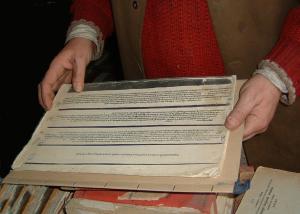
Photocopies from a Nepalese manuscript
The Kashmiri Shaiva texts were edited and printed in the first half of the 20th century. However, it was not until the mid-1960s that they began to be studied systematically. The Nepalese German Manuscript Preservation Project, based in Kathmandu, started soon after in 1970. Over a period of more than thirty years the project photographed millions of sheets of Sanskrit manuscripts, the majority of which are of Tantric texts. The climate in the Kathmandu Valley allows the preservation of manuscripts in large numbers, some of which are over a thousand years old. The inhabitants of the Kathmandu Valley have always had a special predilection for Tantrism in all its forms and schools, especially those centred on goddesses and preserve, in their own regional form, traditions that developed prior to the 11th century. Accordingly, they continued to copy manuscripts of early Tantras lost elsewhere in the Indian subcontinent. Thus amongst the many manuscripts photographed we find a good number of early unpublished texts to which the Kashmiri “Shaiva texts refer.
Monistic Kashmiri Shaivites such as Abhinavagupta accepted the Bhairava and Kaula Tantras as their prime authorities. These focus on the worship of Bhairava (a wrathful form of Shiva) and goddesses. Twelve of these Tantras, all edited from Nepalese manuscripts by Mark Dyczkowski, are amongst the e-texts of the digital library. They include Tantras of the Kalikula that developed into the Krama system of Kashmiri Shaivism, centred on the worship of various forms of Kali. They also include the Sritantrasadbhava, an important and extensive Tantra of the Trika school which Kashmiri Shaivites adopted as their own.
Another important early school, although hardly known to the Kashmiris, focuses on the goddess Kubjika. Two Tantras of this tradition, edited for the first time, are available as searchable e-texts in the Muktabodha digital library. Other e-texts in the digital library are attributed to Matsyendranatha, one of the most important founder figures of the early Tantric Kaula schools.
Along with the Kashmiri Shaivites, to which we have referred, the Kashmir Valley was also the home of more dualistically minded Shaivites who focused more specifically on the public worship of Shiva. They adopted the Siddhanta Agamas as their prime authority and wrote commentaries on some of them as well as independent theological treatises in which they expounded and defended the theology and metaphysics of the Siddhanta Agamas. Although they were not pure monists as their Kashmiri Shaiva brothers were, they were a source of much inspiration for the latter who also drew from the Siddhanta Agamas and related texts, whose doctrines they presented in the framework of their own monistic idealism.
Although it is not possible to locate the places where the first Agamas were redacted, the earliest expounders of the Siddhanta were these Kashmiris. Nowadays, Shaiva Siddhanta is virtually unknown in North India whereas it flourishes vigorously in the South. Their exegeses and commentators in Sanskrit and Tamil contributed to its further development, ignoring or even criticizing the earlier North Indian Siddhantins. Moreover, comparison of the Siddhanta Agamas found in South India with the few Siddhanta manuscripts preserved in Nepal reveals that substantial changes and additions were made to the Agamas in the South.
Although Siddhanta Shaivism has many millions of followers, editions, many of which are hardly more than printed versions of corrupt manuscripts, were published in South India only in the first half of the 20th century. And the first critical editions and systematic studies were begun only in the late fifties. One of the first pioneers in this field was Pandit N. R. Bhatt of the EFEO in Pondicherry, who produced the first critical editions of Siddhanta Agamas and commentaries. It was also under his initiative that the paper transcripts of the French Institute of Pondicherry were produced. These transcripts are among the most important sources for the study of Siddhantic Shaivism. The conversion of the most important of these transcripts into an electronic format that can be easily searched and edited is one of Muktabodha's aims. The Muktabodha Digital Library already contains several e-texts of Siddhanta Agamas, commentaries and independent Siddhanta works typed from printed sources.
The rest of the texts in the library are mostly Tantras and related works of the late period, that is, the 12th century onwards. These include texts of the Srividya (Tripura) tradition and Shakta (Kaula) Tantras redacted in the North of India, especially Bengal. Amongst them are major, well-known compendiums, such as the Saradatilaka, the Nepalese Purascaranarnava, the Tantrasamuccaya, written in Kerala and the Bengali Sritattvarthacintamani by Purnananda and Brhattantrasara by Krsnananda. They supply a great deal of information concerning the worship of specific goddesses such as Tara, Kali and Tripura as well as popular groups of goddesses such as the Ten Mahavidyas.
Another area in which the Library has recently begun to develop is the Vaishnava Tantras of the Pancaratra and related works. The first of these typed for the Library is the Ahirbudhnyasamhita. This is an important early Vaishnava Tantra, probably redacted in Kashmir and strongly influenced by Shaivism. The Samvitprakasa by the early 10th century Kashmiri Vamanadatta (edited by Mark Dyczkowski) is an early monistic Vaishnava theological tract. The Agamapramanya by Yamunacarya (11th century) is one of the earliest independent works of the Vaishnava Pancaratra. The Library also has the Pancaratraraksa by the eminent South Indian scholar, Vedanta Desika who lived in the 14th century. In the near future, the three main Tantras of the Pancaratra, the so-called Three Gems, will be put up. These are the Satvata, Jayakhya and Puskara samhitas.
In the 1960s Prof. Daniel Smith directed a major project in South India to transcribe manuscripts of Vaishnava Pancaratra texts and collect rare printed editions of them. The resulting collection of over 125 transcripts and printed books is uniquely valuable for scholars. Selections from this collection will be an upcoming focus of the e-text collection.
Finally, texts dealing with Yoga, like Tantra, are another
major concern of the Muktabodha Digital Library. Almost twenty Yoga
Upanishads and the Shivasamhita have already been put up. We look
forward to adding others from the Natha tradition as well. Our goal
being the creation of an on-line depository of the major primary
sources of the most important schools of Tantra and Yoga.
PHASE IV DIGITIZING MAJOR COLLECTIONS
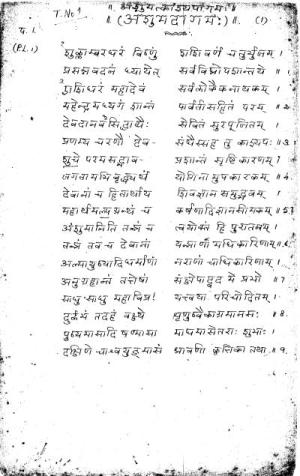
Page 1 of the first paper transcript of the IFP
A manuscript of the Amshumadagama
The Paper Transcripts of the French Institute of Pondicherry
Under a collaborative agreement between the Muktabodha Indological Research Institute, The French Institute of Pondicherry (IFP), and the Ecole Francaise d'Extreme Orient (EFEO), the catalogue and photographic facsimiles of THE PAPER TRANSCRIPTS OF THE FRENCH INSTITUTE OF PONDICHERRY comprising over 210,000 pages and over 2,000 mostly Shaiva texts is now made available to the worldwide scholarly community in the Muktabodha On-line Digital Library. These transcripts are a core component of the largest and most important Shaiva Siddhanta collection in the world, THE SHAIVA MANUSCRIPTS IN PONDICHERRY. In recognition of their importance these were deemed a UNESCO "Memory of the World" Collection in 2005.
Everyone who studies the Shaiva Siddhanta, one of the major streams of the worship of Shiva must inevitably consult these PAPER TRANSCRIPTS OF THE FRENCH INSTITUTE OF PONDICHERRY. The importance and history of the collection is described in detail on its introductory page.
OTHER ON-LINE COLLECTIONS OF MUKTABODHA
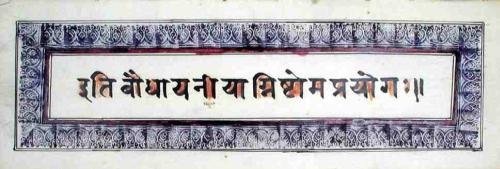
Cover of a Baudhayana manuscript from the private collection
of the Joglekar family of Gokarna, Maharashtra
The Vedic Manuscripts of Gokarna
The majority of the Vedic manuscripts in the Muktabodha archives are palm-leaf manuscripts in Grantha script on microfilm and still await cataloguing. However one of Muktabodha's Vedic digitally photographed manuscript collections is in devanagari script on well preserved paper manuscripts.
These are Ashvalayana, Baudhayana, and Hiranyakeshin manuscripts from the private collections of the Joglekar, Koglekar and Sambha Diksita families of Gokarna, Maharashtra. With the families authorization we have published a representative sample of these manuscripts in the digital library and the entire collection of about 200 manuscripts will be made available in the library in the future.
The Devakottai Series
Also published in the Muktabodha's Digital Library are 24 volumes of the Shaiva Siddhanta Paripalana Sangha Devakottai Series, photographed from the collection of the French Institute of Pondicherry and from other private collections. The Association for the Protection of the Teachings of the Shaiva Agama was established in Devakottai, Tamil Nadu, in the first quarter of the 20th century and directed by Krishna Shastri and his successors.
These volumes produced by the organization are printed editions of Shaiva Siddhanta texts, mostly produced from single manuscripts and mostly in the South Indian scripts.
Tantric searchable e-texts from printed editions by Sudhakar Malaviya
Among the larger e-texts created from previously published editions are some core Tantric created from printed editions in devanagari created by Dr. Sudhakar Malaviya. They were converted from the devanagari pagemaker files of the printed editions by conversion routines written in-house by Harry Spier.
The volumes created in this manner are:
- Jnanarnava Tantra (edited by Dr. Malaviya
- Kamakalavilasa Tantra
- Kularnava Tantra
- Netra Tantra
- Sharadatilaka
- Svacchanda Tantra
- Tantraloka with Jayaratha's commentary
- Uttarakhanda Rudrayamala Tantra
